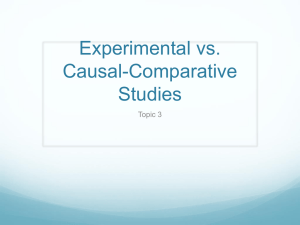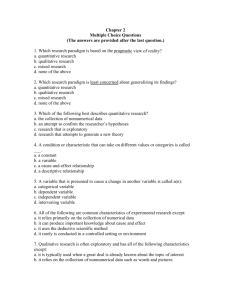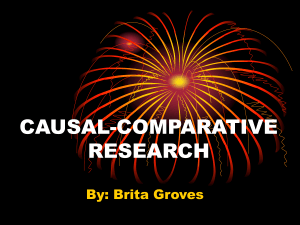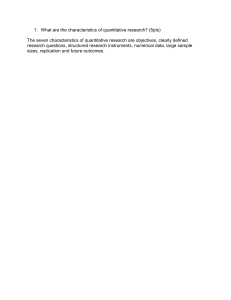Uploaded by
Crosel David
Quantitative Research Types: Descriptive, Experimental & More
advertisement
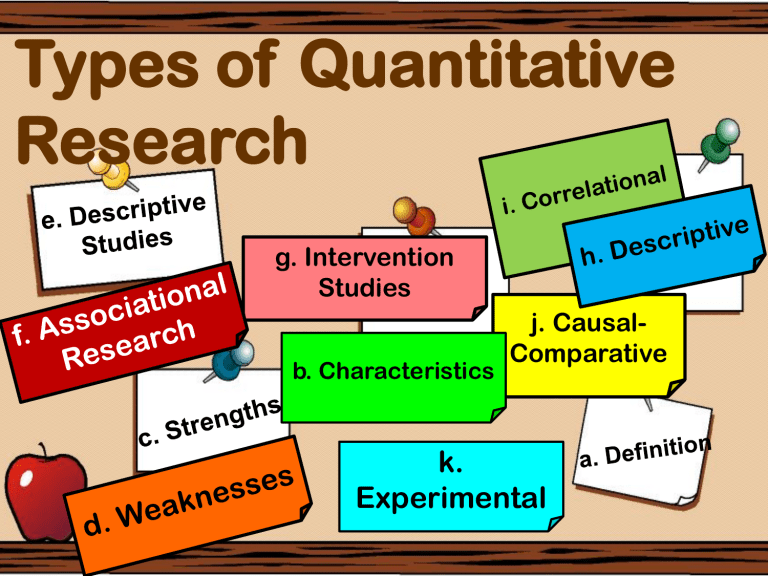
Types of Quantitative Research g. Intervention Studies b. Characteristics j. CausalComparative k. Experimental 1. Definition of a Quantitative Research Quantitative Research, according to Aliaga and Gunderson, (2000), is explaining phenomena by collecting numerical data that are analyzed using mathematically based methods. Frequency Distribution The scores of 28 students in an examination in mathematics are as follows: 26 49 50 56 59 61 63 30 49 52 58 59 61 65 42 50 53 59 60 62 65 48 50 56 59 60 62 69 STEPS: 1. 2. 3. 4. 5. Get the highest score (HS) and the lowest score (LS). Compute the range. Determine the number of steps of cases for the table . This is the class number . Compute the interval. i=Range/CN . Determine the Starting Number. From the SN move up the table by the multiples of i until the highest score is accommodated in the bracket. 5. 6. Tally the scores in the table. Range=43 CN=7 i=7 SN-21 CLASS CLASS FREQUENCY 70 63-69 4 63 56-62 13 56 49-55 7 49 42-48 2 42 35-41 0 35 28-34 1 28 21-27 1 21 (SN) FREQUENCY Present the following scores in frequency distribution using 7 classes/groups. 27 45 54 61 68 72 80 29 50 55 62 69 75 81 35 50 56 63 69 78 90 38 51 59 65 70 78 95 40 51 60 66 70 79 96 The ages of a sample of senators are: 28 49 50 56 59 61 63 30 49 52 58 59 61 65 42 50 53 59 60 62 65 48 50 56 59 60 62 70 a. Prepare a frequency distribution using 10 groups/classes. b. Graph the data using bar graph or pie chart c. Interpret the result. Characteristics of Quantitative Research 1. It is reliable and objective. 2. It uses Statistics to generalize a finding. 3. It reduces and restructures a complex problem to limited number of variables. 4. It test theories or hypotheses. 5. It assumes that the sample is a representative of the population. Advantages of Quantitative Research 1. It allows the researcher to measure and analyze the data to arrive at an objective answer. 2. The result is reliable since the study uses a big sample of the population. 3. Personal biases can be avoided since personal interaction is not part of the research process. Advantages…. 4. Standards are usually used in choosing the instruments, in sampling procedures, and in choosing the most appropriate statistical treatment, thus making the research replicable. 5. Results can be reduced through statistical treatments and interpreted in a few statements. General Research Types Descriptive Associational Intervention Types of Quantitative Research Quantitative Experimental True Experimental QuasiExperimental Single Subject Non-Experimental •Survey • Observational •Correlational •Descriptive • Comparative Descriptive — is the most widely used research design. — its common means of obtaining information include the use of the questionnaire and personal interviews. — is used to describe characteristics of a population of phenomenon being studied. 1. Frequency of Tardiness and Absences among Senior High School Students in Selected Public Schools Example Example 2. A Study of Students’ Satisfaction Level from Educational Services Provided by B.S. ANHS Example 3. Buying Behavior of Selected Consumers of Concepcion, Tarlac Correlational ∞ Correlational research is also known as associational research. Continuation… ∞ Correlational research describes the relationships of the variables via correlation coefficient. Examples 1. The longer the couples have been together, the more similar they are in their attitudes and opinions? 2. A researcher finds that students who have more absences gets lower grades. Example Suppose that you notice That kids who sit in front of Class typically get higher grades. 3. Causal-Comparative The Nature of CausalComparative Research 1. Causal comparative seeks to identify associations among variables. 2. Causal-comparative research attempts to determine the cause or Consequences of differences that already exist between or among groups of individuals. There are three types of causal-comparative research they are enumerated as follows: A. Exploration of Effects B. Exploration of Causes C. Exploration of Consequences 4. A Causal-Comparative Study is often used as an alternative of experimental studies. Causal-Comparative Versus Correlational Research The basic similarity between causalcomparative and correlational study is that both seek to explore relationships among variables. Causal-Comparative Versus Experimental Research In experimental research, the group membership variable is manipulated; in causal-comparative research, the group differences already exist. 4. Survey Research The Purpose of Survey Research 1. The major purpose of all surveys is to describe the characteristics of a population. 2. Rarely is the population as a whole studied, however. Instead, a sample is surveyed and a description of the population is inferred from what the sample reveals. Experimental research is unique in that it is the only the type of research that directly attempts to influence a particular variable and it is only type that, when used properly, can really test hypotheses about cause-andeffect relationships. Essential Characteristics of Experimental Researches Comparison of treatments Manipulation of one or more independent variables Randomization Random Selection Random Assignment True Experimental Research Treatment Control and Experimental Group Randomization • Key: X • Key: O1 and O2 • Key: R Major Considerations in True Research Quasi Experimental Research No randomization! Single-Subject Experimental Research Single-subject Research, at time referred to as single-case research, is a quantitative approach to examine functional relationships between baseline and experimental conditions as over time within individual subjects. Identify the appropriate research design based on the given title Is there a treatment? N O YE S Is the primary purpose examination of relationships? N O YE S Is the treatment tightly controlled by the researcher? Will the sample be studied as a single group? Descriptive Design YE S Correlational Design N O YE S Will a randomly assigned or selected control group be used? Quasiexperimental Design YE S True experimental Design
